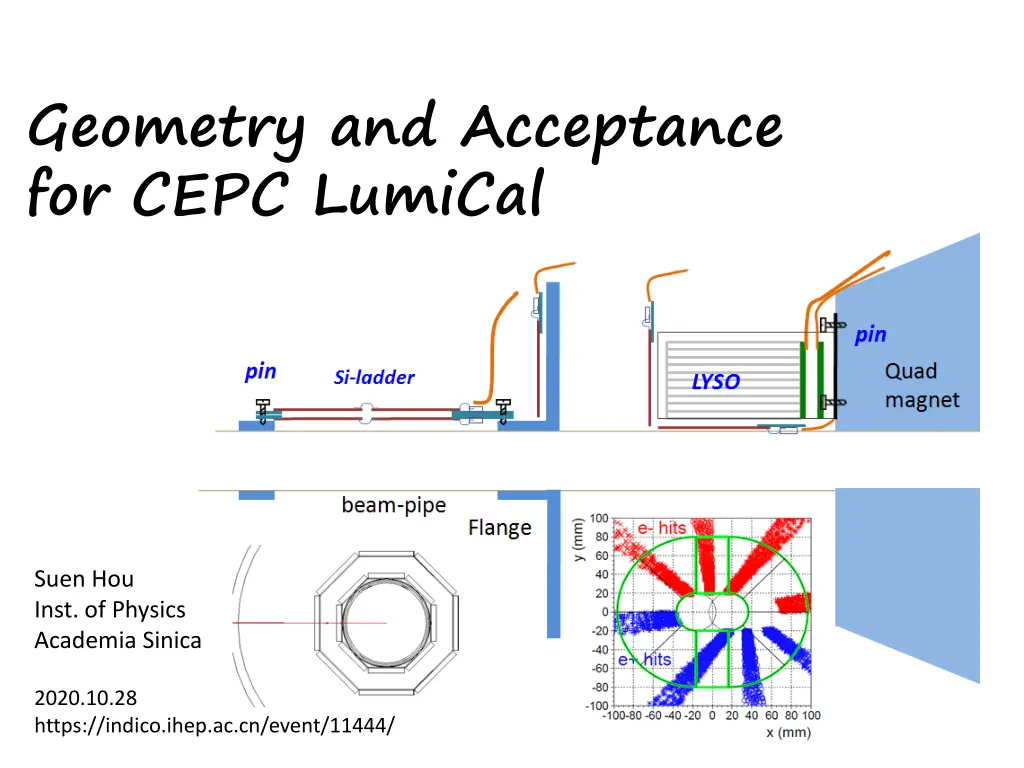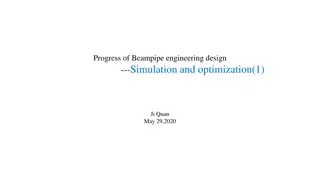
LumiCal Geometry and Acceptance for CEPC Research
Explore the geometry and acceptance criteria for the CEPC LumiCal detector, focusing on precision calculations, event detection, and systematic errors. This research delves into luminosity precision, Bhabha elastics scattering, and electron impact positions with critical design goals and boosted calculations for enhanced accuracy.
Download Presentation

Please find below an Image/Link to download the presentation.
The content on the website is provided AS IS for your information and personal use only. It may not be sold, licensed, or shared on other websites without obtaining consent from the author. If you encounter any issues during the download, it is possible that the publisher has removed the file from their server.
You are allowed to download the files provided on this website for personal or commercial use, subject to the condition that they are used lawfully. All files are the property of their respective owners.
The content on the website is provided AS IS for your information and personal use only. It may not be sold, licensed, or shared on other websites without obtaining consent from the author.
E N D
Presentation Transcript
Geometry and Acceptance for CEPC LumiCal Suen Hou Inst. of Physics Academia Sinica 2020.10.28 https://indico.ihep.ac.cn/event/11444/
Outline CDR LumiCal: CDR version a Si-W stack, w.o. beam-pipe reality post-CDR: beam-pipe geometry & multiple scattering round beampipe Si-ladder + Crystal Calorimeter Bhabha cross section @ Z pole : BHLUMI calculation done for min= 30 mRad (Bhabha) = 75 nb GEANT study for luminosity precision L/L ~ 10-4 multiple scattering passing 1mm Al beampipe RMS = 50 um @Z=0.5m, = 30 mRad LumiCal Geometry and Mechanics for L/L ~ 10-4 Si-ladder: detect electron impact position to ~ 1.5 Rad Si-wafer surrounding beampipe, do Z-position measurement LYSO Calorimeter: ID beam-electron/photon 2
Luminosity criteria Luminosity of e+e collisions by QED Bhabha elastics scattering theoretical precision < 0.1 % e+e e+e crosss section e+e collision Integrated luminosity Reference to Z-lineshape e+e Z qq = 41 nb Scattered electron theta distribution Detecting Bhabha event RIGHT Bhabha detected In a fiducial region LEFT 3
Bhabha detection e+e e+e elastics scattering Event signature 1. E(e ) = Ebeam 2. e+ , e Back-to-Back NLO e+e e+e ~1% of total events 1. e+ , e approximately Back-to-Back 2. one electron E < Ebeam 3. e/ ID, spatial resolution X,Y RIGHT LEFT 4
Luminosity precision Dominant systematic error L/L ~ 2 / min For precision of L/L < 10-3 LumiCal @Z= 1 m, ref: min= 30 mRad eq. r = 30 mm = 15 Rad eq. dr = 15 m Error due to offset on Z 0.1 mm on z dr = Rx = 3 m Bhabha -angle distribution detector spatial resolution Fiducial region LumiCal design goal: Spatial res.: narrow binning Standard error of the mean on min: / N < 15 Rad offset on fiducial edge Systematics to the mean on min LUMINOSITY error min 5
Bhabha boosted by CEPC 33 mRad beam crossing BHlumi QED calculation for Bhabha e+e scattering boosted for the 33 beam crossing e+,e shift by ~16.5 mRad to +x direction Opening angle pi of the scattered e+,e Electrons shifted from CMS to LAB Bhabha electron x-y distribution at Z=1m 6
LumiCal acceptance, compare BHlumi with Beampipe design X-Y hits both e+,e detected at CEPC Z= 1 m Y. Liu 2020.10.14 r=30mm BHLUMI estimate boosted electron distribution for a round beampipe min= 30 mRad CMS LAB detecting one electron 102535 262 nb both electrons 29194 74.6 nb range: 10 ~ 80 mRad Nevents 457232 Xsec (nb) 1168.3 *latest beampipe before Flange @Z=655 mm, acceptance suggested for min>38 mRad LumiCal Acc < 40 nb 7
GEANT, multiple scattering off beampipe Si-ladders surrounding beampipe minimal smearing by multiple scattering/shower Electron traversing 1 mm thick Al beampipe @30 mRad, Z = 0.5 m, dZ traversing beampipe = 33 mm GEANT multiple scattering Passing 1 mm beampipe Impact position on Si-layer RMS = 50 m
GEANT TUBE beam-pipe, Si-ladders acos(.99) = 141.54 mRad @Z=118 r= 16.81 (=tanQ*118) acos(.992)= 126.58 mRad @Z=118 r= 15.02 mm Q= 100mRad @Z=118 r= 11.84 mm @Z=153 r=15.35 mm Acos(.99) = .14154 rad Acos(.992) = .1266 rad atan(123.6/970) = .12678 rad 409 TbFe 5mm Fe Z=0~ 970 mm connecting to r= 12.34cm ~+.5cm, FE TbOS 2mm scin Z=0~ 970 mm r= 12.39cm +.2cm TbIS 2mm scin Z=0~ 970 mm r= 12.32cm +.2cm Acos(.992) =.1266 rad Flng 10mm thick flange Z=520~530 mm r= 55~123.2 mm SiW edge atan(70/685) =.1018 rad Al dual tubes .5mm, .35 mm thick Flange Fwin window 2 mm Z=520~522 r= 15.35~55 mm 100 mrad 419 FLSi Si deck Z=522~524 R = 15.5-55. mm 29.7-105 mrad FS0i SiW two layers Deck=3.5mmW+2mmAir R = 15.5-70. mm 22.3-100.2 mrad @ Z= 696 BpSn Si octagon rmin =1.5451 cm Z=16 - 52.0 cm Z=115 mm Z=118 mm Fend Flange 20mm Z=696 - 716 r= 15.5~123.2 mm 15 mm Z=520 mm 14 mm 401 InBPipe InBP Inner Be pipe Z=0~118 mm, inner diameter 28 mm 0.5mm thick Fpip flange pipe 1.5 mm thick Z= 522-716 mm at Z=512 r= 14 15.5 mm InAl Inner Al pipe Z=118~500 mm, inner diameter 28 mm 0.5mm thick OuBP outer Be pipe Z=0~115 mm inner radius 28/2+1 mm 0.35mm thick OuAl outer Al pipe Z=0~115 mm inner r=28/2+1 mm, 0.35 mm thick
Piled up of 50 GeV electron shower hits Position(Hits) Electron shower Front 2 Si-layers of Q-pole LumiCal Pileup of shower ~1 mm resolution Three Si layers at Z>670 mm NO Tungsten layers = 65 um 1st Si layer behind flange at Z=515 mm Octagon Si-ladders surrounding beampipe 1stlayer = 50 um 10
Options of LumiCal assembly 2D Si-ladder assembled on CNC table z-strips for theta position: <200 m pitch for resolution <25 m phi-strips: ~ 1 mm pitch to correct boosted direction alignment pin to beampipe support precision ~5 m CNC survey of Si strip position ~ 3 m Bhabha electron resolution: @fiducial edge, assuming min= 30 mRad L/L < 10-4 = 1.5 Rad @ Z= 0.5 m, corresponding to dr= 0.75 m; dz = dr/tan(.03)= 25 m Heat dissipation: 8 pairs of z-phi ladders, 30 chips 100 W /per z-side (APV25 0.4 W/chip, 28 chips in Z, 128 ch, 0.1 mm pitch z-coverage = 360mm) use fine-pitch Si-strip to differentiate Mult.Scatt. distribution (50 m width) for event counting over min to 25 m precison pin pin Quad-mag Si-ladder LYSO Flange beam-pipe
LumiCal Si-wafer option o LumiCal Si wafer volume GEANT for round beampipe = 28 mm = 30 mRad @ z=500 mm Multi. Scattering at Si wafer: RMS = 50 m z=620 mm Assuming Si strip 300 m thick, pitch = 100 m, resolution by the fraction of entrance strip (low z) fire 100 strips @ 30 mRad rather extreme for Si strip resolution by charge sharing at the edge strips 12
LumiCal Calo options Upstream to Calo: beam-pipe, flange, possibly ~5 X0 shower center ~1 mm precision o Calorimeter option: LYSO + SiPM to minimize space for electronics o Si-layers in flange/Calo front as preshower layers for e/ ID, NLO photon o Calo Assembly: LYSO in 2x2 cm2bars ~50 kg ring, mounted on Magnet fabrication may be better than 10 m More detailed works needed !! Si strip disks In Flange IP Octagon Si-strip in z 13
Summary o Bhabha detection studied for luminosity L/L ~ 10-4 optimizing acceptance for Z(qq) pole cross section o Detecting electron, resolution at min edge : L/L ~ 10-4 min= 1.5 Rad Si-ladders surrounding beam-pipe: electron Z position (@30mRad), min measuring Bhabha electrons with impact position smeared by Multiple-Scattering Z = 25 m Calo (LYSO+SiPM) for e/ identification further details to be studied ! min 14

